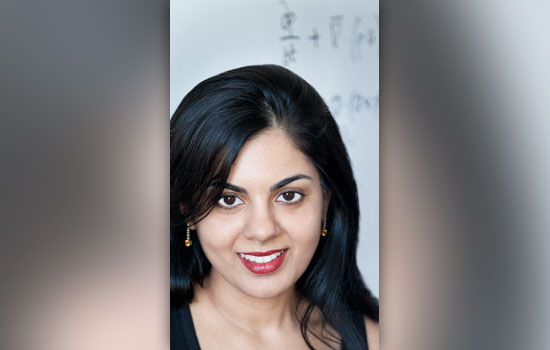Astrophysicists to probe dark matter in California
RIT professor brings together leaders in the field for American Astronomical Society conference
Photo provided
Sukanya Chakrabarti
Uncloaking the secrets of dark matter in the universe is a cosmological conundrum puzzling some of the brightest astrophysicists.
An upcoming conference, sponsored by the American Astronomical Society and organized by Rochester Institute of Technology professor Sukanya Chakrabarti, will probe the mass that does not absorb or emit light, and which is never seen, only inferred by its gravitational effects on other objects.
Probes of Dark Matter on Galaxy Scales 2013, will be held July 14–19 in Monterey, Calif. Chakrabarti, conference organizer and chair, and co-chair Leo Blitz, professor of astronomy at University of California at Berkeley, have invited leaders of the field to meet and discuss their techniques for solving the riddle of dark matter.
“The idea is to bring together people working on different probes of dark matter from dynamics, which is my area, to gravitational lensing, to indirect probes of dark matter like gamma ray radiation and to get everyone together,” says Chakrabarti, assistant professor in RIT’s School of Physics and Astronomy.
Computational astrophysicist Chakrabarti developed the “tidal analysis” method for probing dark matter while on a post-doctoral fellowship at UC Berkeley in 2009. An observational data set of the Milky Way compiled by a graduate student inspired her current research.
“When I saw this map of our own galaxy, it was clear to me that the structures we see at the outskirts of our galaxy could not have been produced in a purely isolated context,” she says. “I started doing computer simulations of our galaxy interacting with neighboring dwarf galaxies.”
Chakrabarti’s method started simply. “I was asking the question: If the structures that you see in the gas disk of our galaxy are due to a satellite of our galaxy, how massive does the satellite have to be and where does it have to be?”
In 2011, she analyzed disturbances in a dwarf galaxy in nearby Galaxy M51, or the “Whirlpool Galaxy,” which has an optically visible dwarf satellite. Dwarf or satellite galaxies contain only a fraction of stars found in the larger spiral galaxy and are dim in comparison. Charkabarti’s method successfully tracked the gravitational imprints of the satellite and allowed her to infer its mass and relative position.
“Tidal analysis gives us a way of hunting for dark-matter dominated dwarf galaxies,” Chakrabarti says. “And the reason this is useful is that most of them are very dim. It’s hard to see them if you are just looking for the optical light they emit. It’s sort of like looking for a car with dim headlights in a fog. If we knew approximately where to look, that would give observers an advantage.”
A few dozen dwarf galaxies are known to surround the Milky Way. The current cosmological paradigm predicts more satellite galaxies than have been observed, Chakrabarti says.
“The question we’re trying to address is, can we find these predicted satellite galaxies by looking for their gravitational footprints on the outer gas disks of galaxies?”
Following her initial success with Galaxy M51, Chakrabarti is applying her method to the outer edges of the Milky Way. Her current work analyzes the structures in the outskirts of the hydrogen gas disk to uncover new dwarf galaxies. She will present her latest research in an invited talk at the American Astronomical Societymeeting in Indianapolis, Ind., June 2–6.
Chakrabarti focuses mostly on the dynamics of gas flow in galaxies. She appeared on the Weather Channel series Deadliest Space Weather earlier this year to talk about the gas giant Jupiter and the reason why the centuries-old hurricane that forms the Great Red Spot has not dissipated.
“The basic physical principles are the same whether you are talking about turbulence as applied to aircraft, if you’re studying planes going through turbulent flows on earth; or whether you’re looking at Jupiter’s Great Red Spot; or whether you’re looking at gas flows on even larger scales—galaxies,” Chakrabarti says. “That’s the really exciting thing about astrophysics. You can use the same physical principles to understand a very wide range of phenomena from the earth to the solar system to galaxies.”















